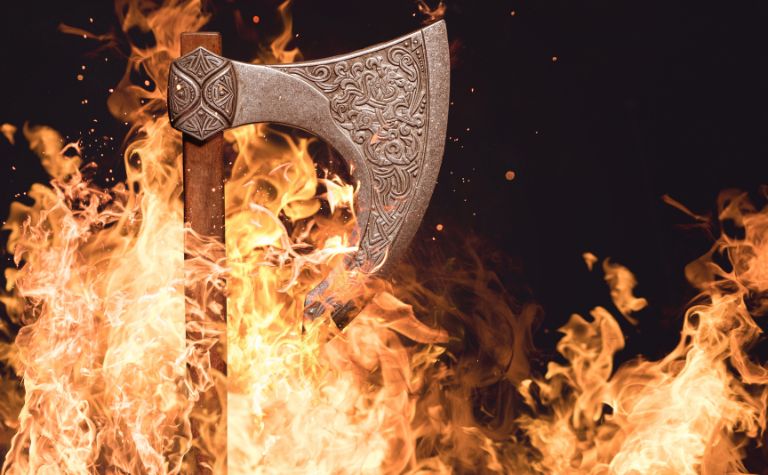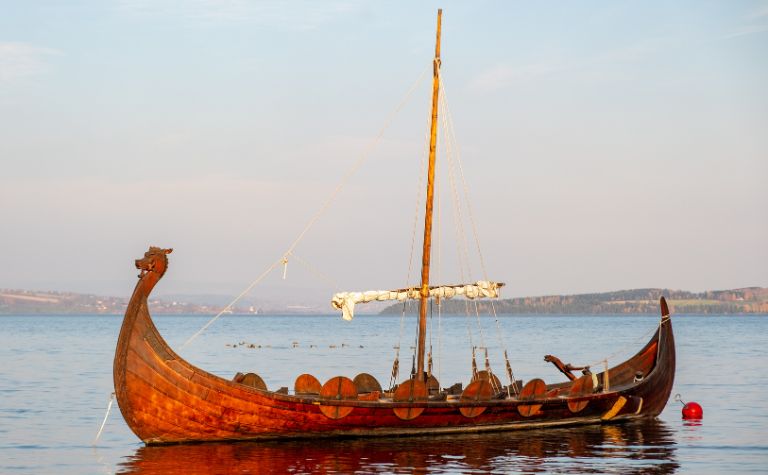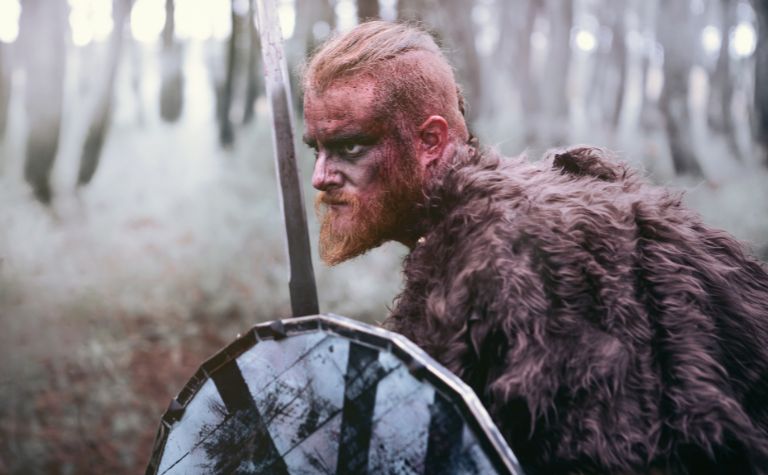In the “Vikings” series, the character known as “the Wanderer” sparks intrigue. He’s a charismatic storyteller whose real identity is mysterious.
Is he a divine entity or a clever deceiver? His story prompts deeper exploration into the world of Norse mythology and this historical drama.
In “Vikings,” Harbard is considered “the Wanderer.” He’s a charismatic, mysterious figure who appears in season three, mirroring Odin from Norse mythology.
He becomes influential in Kattegat, especially with Queen Aslaug and the children.
What does Norse Mythology have to do with the Wanderer? What does Odin have to do with Harbard? What is Harbard’s story arc in Vikings? How does the Wanderer and Harbard fit within the narratives and themes of the third season of Vikings?
Keep reading to learn the answers to these questions and others.
Also, see Who Is Astrid in Vikings? to learn more.

The Wanderer’s Identity Is Linked to Norse Mythology
Harbard, a mysterious character who appears in the show’s third season, can be considered “the Wanderer.”
His character is based on the Norse god Odin, often called “the Wanderer” in mythology.
Harbard, played by actor Kevin Durand, first appears in Kattegat while the Viking warriors are away raiding.
His name means “Grey Beard” in Old Norse, which is one of the many names used by Odin when he wanders the Earth in disguise.
He presents himself as a charismatic, wandering storyteller and healer, quickly gaining the trust of many in Kattegat, including Queen Aslaug.
His real identity, however, remains a matter of speculation throughout his appearances.
Harbard’s interactions with other characters, particularly the children of Kattegat, have a significant impact on the storyline.
Some see him as a divine figure with mysterious powers, while others view him as a manipulator.
Why is Odin called the Wanderer in Norse Mythology?
In Norse mythology, Odin, the Allfather and king of the Aesir gods, is often referred to as “the Wanderer.”
This moniker arises from his habit of journeying throughout the Nine Worlds in various disguises, seeking wisdom and knowledge.
He’s depicted as a restless deity, traveling incognito among mortals and gods, engaging in quests for greater understanding, and even making profound sacrifices, such as giving up one of his eyes for wisdom.
His propensity to wander and his quest for enlightenment are key characteristics that have earned him the title “the Wanderer.”
Why is Odin sometimes called “Gray Beard”?
In Norse mythology, Odin is sometimes referred to as the “gray beard” due to the depiction of his physical appearance.
The term “gray beard” symbolizes wisdom, experience, and age, reflecting Odin’s status as the Allfather and the chief god in the Norse pantheon.
His long, flowing beard, often depicted as gray or white, signifies the accumulated knowledge and sagacity that comes with time.
This epithet showcases the reverence and respect given to Odin as a figure of immense wisdom and authority in Norse mythology.

What Is Harbard’s Story Arc in Vikings?
Harbard, also known as “the Wanderer,” first appears in the third season of “Vikings.”
He arrives in Kattegat while the men are away raiding and quickly gains the trust of the community with his captivating storytelling and claimed healing abilities.
The character makes a significant connection with Queen Aslaug, and there’s a romantic subplot between them.
Harbard also interacts significantly with Aslaug’s son Ivar, claiming to relieve him of his painful condition.
However, during Harbard’s stay, several children in the village mysteriously die, and Floki, a character who is deeply spiritual, suspects that Harbard might be a god.
Harbard leaves Kattegat abruptly after these events, leaving Aslaug and the community in shock and grief. He returns in the fourth season, repeating a similar pattern of events.
This time, his departure is followed by the death of one of Ragnar’s sons, Sigurd Snake-in-the-Eye.
Throughout the series, Harbard’s true identity remains a topic of speculation among characters and fans alike.
Some suggest he’s a manifestation of the Norse god Odin, who is known to travel in disguise among mortals in the sagas.
Harbard’s actions, while sometimes seemingly beneficial, often result in harm and tragedy, creating a complex and mystifying character arc.
What is Queen Aslaug’s story arc in the show?
Queen Aslaug’s story arc in the Vikings TV show is a multi-faceted journey that involves various developments and events.
Introduced as the second wife of the legendary Viking Ragnar Lothbrok, Aslaug plays a significant role in the narrative.
Initially, Aslaug is depicted as a mysterious and enigmatic figure who arrives in Kattegat, where Ragnar rules as king.
Her arrival follows a prophetic vision that Ragnar experiences, which leads him to invite her into his life.
Aslaug’s beauty and air of mysticism capture Ragnar’s attention, causing him to take her as his wife despite already being married to Lagertha.
Aslaug’s storyline intertwines with Ragnar’s ambitions and struggles for power.
She eventually gives birth to several sons, including Ivar the Boneless, who goes on to become a formidable and influential character in the series.
Aslaug’s role as a mother and her sons’ unique abilities contribute to the shaping of their destinies and the subsequent events in the show.
Throughout the series, Aslaug faces challenges and conflicts, both within her personal life and as a member of the Viking society.
Her strained relationship with Ragnar, his infidelity, and her struggles for recognition and respect within the community form crucial aspects of her story arc.
Aslaug’s intelligence and cunning nature are showcased as she navigates political complexities and attempts to secure her own position and the future of her sons.
Ultimately, Aslaug’s story arc undergoes a tragic turn. As Ragnar’s quest for power intensifies and tensions rise, he divorces Aslaug, leaving her to face the consequences of his actions.
Her once-prominent role diminishes, and she eventually meets a tragic fate, reflecting the tumultuous and often perilous world of the Vikings depicted in the TV show.

What is Season Three of Vikings About?
“Vikings” Season 3, which aired in 2015, continues the story of the legendary Norse hero, Ragnar Lothbrok, and his companions.
This season delves deeper into Ragnar’s reign as the King of Kattegat and his ambition to explore and raid new lands.
The season begins with Ragnar leading an expedition to Wessex, where he’s been promised land by King Ecbert.
While in England, the Vikings also laid siege to Paris, a well-fortified city that proved to be a significant challenge, testing the Norsemen’s strength, strategy, and unity.
Back in Kattegat, Queen Aslaug and the community are faced with their own trials.
This includes the arrival of Harbard, the Wanderer, a mysterious figure who causes quite a stir among the inhabitants, particularly Aslaug and her children.
This season also delves into the personal lives and relationships of the main characters.
It explores Ragnar’s complicated relationship with his wife Aslaug and his ex-wife Lagertha, the power struggles between the Lothbrok brothers, and the spiritual journey of Floki, a devoted follower of the Norse gods.
Overall, Season 3 of “Vikings” provides a complex blend of historical exploration, political intrigue, personal drama, and spiritual mysticism while presenting a stark and gritty image of the Viking Age.
